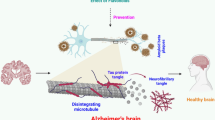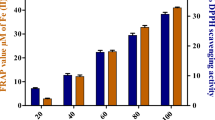Abstract
Neuroinflammation affects millions of people around the world as a result of injury or stress. Neuroinflammation represents almost all types of neurological diseases such as multiple sclerosis and Alzheimer’s disease. Neurodegenerative diseases comprise demyelination and synaptic loss. The inflammatory response is further propagated by the activation of glial cells and modulation of constitutively expressed extracellular matrix proteins. The aim of the present study was to identify the anti-inflammatory effects of purified compounds gallic acid (GA, 1.0 µM) and vanillic acid (VA, 0.2 µM) on the lysolecithin (LPC, 0.003%)-induced model of inflammation. Hippocampal neurons were co-cultured with glial cells, and LPC was added to induce inflammation. Neurite outgrowth was measured by morphometry software. The level of myelination and demyelination was identified by immunostaining and sodium dodecyl sulfate polyacrylamide gel electrophoresis and western blotting techniques using different antibodies. Whole-cell patch clamp recordings were used to observe the sustained repetitive firing pattern. The data showed that GA and VA significantly increased the neurite outgrowth after 48 h in culture. Both compounds significantly reduced the expression of cyclooxygenase-2, NFκB, tenascin-C, chondroitin sulfate proteoglycans and glial fibrillary acidic protein in astrocytes in the LPC-induced model of inflammation. The level of myelin protein in neurites and oligodendrocyte cell bodies was significantly upregulated by GA and VA treatment. The reduction in sustained repetitive firing in the LPC-induced model of inflammation was reversed by both GA and VA treatment. This study supports the hypothesis that VA and GA have anti-inflammatory activities and could be regarded as potential treatments for neurodegenerative disease.









Similar content being viewed by others
References
Jha MK, Jeon S, Suk K (2012) Glia as a link between neuroinflammation and neuropathic pain. Immune Netw 12:41–47
Skaper SD, Facci L, Giusti P (2014) Mast cells, glia and neuroinflammation: partners in crime? Immunology 141:314–327
Harlow DE, Macklin WB (2014) Inhibitors of myelination: ECM changes, CSPGs and PTPs. Exp Neurol 251:39–46
Calixto JB, Campos MM, Otuki MF, Santos AR (2004) Anti-inflammatory compounds of plant origin. Part II. Modulation of pro-inflammatory cytokines, chemokines and adhesion molecules. Planta Med 70:93–103
Calixto JB, Otuki MF, Santos AR (2003) Anti-inflammatory compounds of plant origin. Part I. Action on arachidonic acid pathway, nitric oxide and nuclear factor κB (NF-κB). Planta Med 69:973–983
Bellik Y, Boukraa L, Alzahrani HA, Bakhotmah BA, Abdellah F, Hammoudi SM, Iguer-Ouada M (2012) Molecular mechanism underlying anti-inflammatory and anti-allergic activities of phytochemicals: an update. Molecules 18:322–353
Kim YS, Young MR, Bobe G, Colburn NH, Milner JA (2009) Bioactive food components, inflammatory targets, and cancer prevention. Cancer Prev Res 2:200–208
Hertog MGL, Feskens EJM, Kromhout D, Hertog MGL, Hollman PCH, Hertog MGL, Katan MB (1993) Dietary antioxidant flavonoids and risk of coronary heart disease: the Zutphen elderly study. Lancet 342:1007–1011
Prince PS, Dhanasekar K, Rajakumar S (2011) Preventive effects of vanillic acid on lipids, bax, bcl-2 and myocardial infarct size on isoproterenol-induced myocardial infarcted rats: a biochemical and in vitro study. Cardiovasc Toxicol 11:58–66
Liu KY, Hu S, Chan BC, Wat EC, Lau CB, Hon KL, Fung KP, Leung PC, Hui PC, Lam CW, Wong CK (2013) Anti-inflammatory and anti-allergic activities of Pentaherb formula, Moutan Cortex (Danpi) and gallic acid. Molecules 18:2483–2500
Choi KC, Lee YH, Jung MG, Kwon SH, Kim MJ, Jun WJ, Lee J, Lee JM, Yoon HG (2009) Gallic acid suppresses lipopolysaccharide-induced nuclear factor-kappaB signaling by preventing RelA acetylation in A549 lung cancer cells. Mol Cancer Res 7:2011–2021
Venkatesan R, Ji E, Kim SY (2015) Phytochemicals that regulate neurodegenerative disease by targeting neurotrophins: a comprehensive review. Biomed Res Int 2015:814068
Pavelko KD, van Engelen BG, Rodriguez M (1998) Acceleration in the rate of CNS remyelination in lysolecithin-induced demyelination. J Neurosci 18:2498–2505
Hamill CE, Goldshmidt A, Nicole O, McKeon RJ, Brat DJ, Traynelis SF (2005) Special lecture: glial reactivity after damage: implications for scar formation and neuronal recovery. Clin Neurosurg 52:29–44
Fitch MT, Silver J (2008) CNS injury, glial scars, and inflammation: inhibitory extracellular matrices and regeneration failure. Exp Neurol 209:294–301
Siddiqui S, Horvat-Broecker A, Faissner A (2009) Comparative screening of glial cell types reveals extracellular matrix that inhibits retinal axon growth in a chondroitinase ABC-resistant fashion. Glia 57:1420–1438
Siddiqui S, Horvat-Brocker A, Faissner A (2008) The glia-derived extracellular matrix glycoprotein tenascin-C promotes embryonic and postnatal retina axon outgrowth via the alternatively spliced fibronectin type III domain TNfnD. Neuron Glia Biol 4:271–283
Stettner M, Wolffram K, Mausberg AK, Albrecht P, Derksen A, Methner A, Dehmel T, Hartung HP, Dietrich H, Kieseier BC (2013) Promoting myelination in an in vitro mouse model of the peripheral nervous system: the effect of wine ingredients. PLoS ONE 8:e66079
Fulmer CG, VonDran MW, Stillman AA, Huang Y, Hempstead BL, Dreyfus CF (2014) Astrocyte-derived BDNF supports myelin protein synthesis after cuprizone-induced demyelination. J Neurosci 34:8186–8196
Makar TK, Bever CT, Singh IS, Royal W, Sahu SN, Sura TP, Sultana S, Sura KT, Patel N, Dhib-Jalbut S, Trisler D (2009) Brain-derived neurotrophic factor gene delivery in an animal model of multiple sclerosis using bone marrow stem cells as a vehicle. J Neuroimmunol 210:40–51
Locatelli C, Filippin-Monteiro FB, Creczynski-Pasa TB (2013) Alkyl esters of gallic acid as anticancer agents: a review. Eur J Med Chem 60:233–239
Lirdprapamongkol K, Sakurai H, Kawasaki N, Choo MK, Saitoh Y, Aozuka Y, Singhirunnusorn P, Ruchirawat S, Svasti J, Saiki I (2005) Vanillin suppresses in vitro invasion and in vivo metastasis of mouse breast cancer cells. Eur J Pharm Sci 25:57–65
Hsu JY, Bourguignon LY, Adams CM, Peyrollier K, Zhang H, Fandel T, Cun CL, Werb Z, Noble-Haeusslein LJ (2008) Matrix metalloproteinase-9 facilitates glial scar formation in the injured spinal cord. J Neurosci 28:13467–13477
Fujita Y, Yamashita T (2014) Axon growth inhibition by RhoA/ROCK in the central nervous system. Front Neurosci 8:338
Suzumura A (2013) Neuron–microglia interaction in neuroinflammation. Curr Protein Pept Sci 1:16–20
Kassubek R, Gorges M, Schocke M, Hagenston VAM, Huss A, Ludolph AC, Kassubek J, Tumani H (2017) GFAP in early multiple sclerosis: a biomarker for inflammation. Neurosci Lett 657:166–170
Ji K, Tsirka SE (2012) Inflammation modulates expression of laminin in the central nervous system following ischemic injury. J Neuroinflamm 9:159
Claycomb KI, Winokur PN, Johnson KM, Nicaise AM, Giampetruzzi AW, Sacino AV, Snyder EY, Barbarese E, Bongarzone ER, Crocker SJ (2014) Aberrant production of tenascin-C in globoid cell leukodystrophy alters psychosine-induced microglial functions. J Neuropathol Exp Neurol 73:964–974
Kataria H, Alizadeh A, Shahriary GM, Saboktakin Rizi S, Henrie R, Santhosh KT, Thliveris JA, Karimi-Abdolrezaee S (2018) Neuregulin-1 promotes remyelination and fosters a pro-regenerative inflammatory response in focal demyelinating lesions of the spinal cord. Glia 66:538–561
Yucel-Lindberg T, Nilsson S, Modéer T (1999) Signal transduction pathways involved in the synergistic stimulation of prostaglandin production by interleukin-1beta and tumor necrosis factor alpha in human gingival fibroblasts. J Dent Res 1:61–68
Font-Nieves M, Sans-Fons MG, Gorina R, Bonfill-Teixidor E, Salas-Pérdomo A, Márquez-Kisinousky L, Santalucia T, Planas AM (2012) Induction of COX-2 enzyme and down-regulation of COX-1 expression by lipopolysaccharide (LPS) control prostaglandin E2 production in astrocytes. J Biol Chem 287:6454–6468
Medeiros R, Figueiredo CP, Pandolfo P, Duarte FS, Prediger RD, Passos GF, Calixto JB (2010) The role of TNF-alpha signaling pathway on COX-2 upregulation and cognitive decline induced by beta-amyloid peptide. Behav Brain Res 209:165–173
Satoh H, Amagase K, Ebara S, Akiba Y, Takeuchi K (2013) Cyclooxygenase (COX)-1 and COX-2 both play an important role in the protection of the duodenal mucosa in cats. J Pharmacol Exp Ther 344:189–195
Lawrence T (2009) The nuclear factor NF-kappaB pathway in inflammation. Cold Spring Harb Perspect Biol. https://doi.org/10.1101/cshperspect.a001651
Ghasemlou N, Jeong SY, Lacroix S, David S (2007) T cells contribute to lysophosphatidylcholine-induced macrophage activation and demyelination in the CNS. Glia 55(3):294–302
Acknowledgements
The authors are gratified for the Research Grant # 2680 provided by Higher Education Commission (HEC) of Pakistan.
Author information
Authors and Affiliations
Corresponding author
Ethics declarations
Conflict of interest
The authors declare no conflict of interests.
Ethical approval
The experiments were performed to the Protocol 2015-0007, assigned by Advisory Committee on Animal Standards, ICCBS, University of Karachi.
Additional information
Publisher’s Note
Springer Nature remains neutral with regard to jurisdictional claims in published maps and institutional affiliations.
Electronic supplementary material
Below is the link to the electronic supplementary material.
11033_2018_4557_MOESM1_ESM.tif
Supplementary material 1 (TIF 4782 KB) Supplementary Fig. 1 Dose–response effects of gallic and vanillic acid on hippocampal neurite outgrowth. a–d Neurons were cultured in the presence of different concentrations of GA and VA acid (µM: 0.1, 0.2, 0.5, 1, 1.5) for 48 h. a, c Mean average lengths of the 10 longest neurites from each group. b, d Sum of all neurite lengths was calculated as the sum of all neurites in each group (n = 180). Neurite lengths were measured by tracing the entire length of the neurite from the cell body. The results are shown as the means ± SD. Statistical differences were revealed by Mann–Whitney U-test. **p < 0.001
11033_2018_4557_MOESM2_ESM.tif
Supplementary material 2 (TIF 5956 KB). Supplementary Fig. 2 Expression of proteins. a and b Primary oligodendrocytes were stained with antibodies against TN-C and CSPGs. Asterisks shows the oligodendrocytes. Scale bar = 50 µm. c Neurons were stained with antibody against neurofilament. d Cortical astrocytes were stained with antibody against GFAP. Arrows represents neurons or astrocytes. Scale bar = 25 µm. e and f Neuroglial co-culture immunostained with antibodies against LN and CSPGs. Arrows represents neurons and arrowheads represents neurites. Scale bar = 25 µm. g and h Neurons were stained with antibodies against CSPG and TN-C. Asterisks shows neurons. Scale bar = 50 µm. i and j Astrocytes were stained with antibodies with LN and TN-C. Asterisks shows the astrocytes. Scale bar = 50 µm
Rights and permissions
About this article
Cite this article
Siddiqui, S., Kamal, A., Khan, F. et al. Gallic and vanillic acid suppress inflammation and promote myelination in an in vitro mouse model of neurodegeneration. Mol Biol Rep 46, 997–1011 (2019). https://doi.org/10.1007/s11033-018-4557-1
Received:
Accepted:
Published:
Issue Date:
DOI: https://doi.org/10.1007/s11033-018-4557-1




